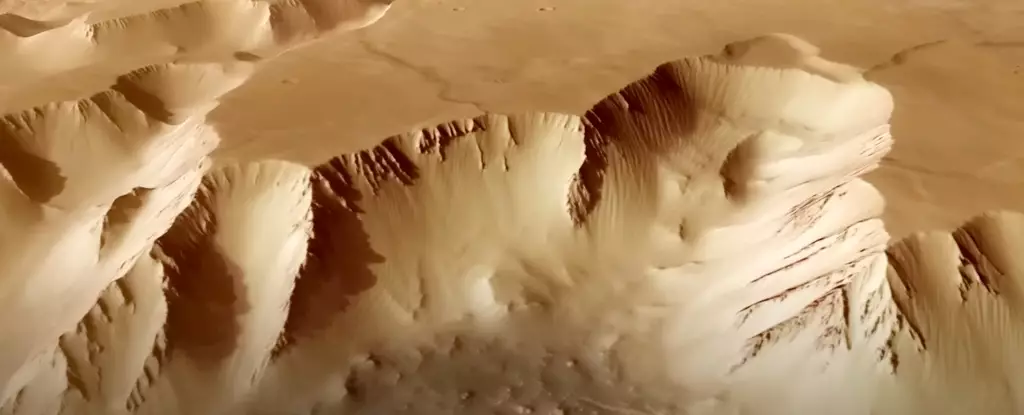

As humans, we have always been intrigued by the mysteries of space and the planets beyond our own. Mars, in particular, has captured our imaginations with its potential for future exploration and scientific discoveries. Among the many fascinating features on the Red Planet, one stands out in its complexity and beauty – the Noctis Labyrinthus, or the “Labyrinth of Night.” This mesmerizing region, situated between Mars’s Valles Marineris and the colossal Tharsis Bulge, is a system of valleys that stretches across an impressive 1,200 kilometers.
The Noctis Labyrinthus wasn’t formed overnight; it is a result of the intricate geological history of Mars. The underlying cause of these valleys lies in the Tharsis Rise region, where volcanic activity led to the formation of a bulge. This geological upheaval exerted immense tectonic stresses on the surrounding areas, resulting in the thinning of the Martian crust. The process created structures known as “grabens,” which are essentially trenches that settled down as the crust stretched and thinned.
Some of these grabens in the Noctis Labyrinthus are remarkably deep, reaching depths of up to 5,000 meters. These fractures and grabens offer insights into the tectonic forces that shaped Mars’s ancient past. A flight over this region takes us on a captivating journey through time, allowing us to envision the planet as it appeared before the tectonic activity and surface erosion took their toll.
By studying the Mars Express spacecraft’s animation, composed of thousands of images captured by its cameras, we gain a glimpse into millions of years of Martian geologic history. The intersecting canyons and valleys, carved by volcanic stresses, may seem insignificant in the flyover, but they can reach widths of up to 30 kilometers and depths of six kilometers. Over time, massive landslides have cascaded down the slopes, concealing the older surface units beneath them.
Additionally, the video reveals the presence of large dune fields on some valley slopes. These dunes formed as winds on Mars blew sand across the surface, shaping the landscape over time. The flyover encapsulates the complexity of Martian geology, somewhat akin to flying over Earth’s Grand Canyon and observing the deep cross-cutting fracture zone at its base. The Noctis Labyrinthus exposes the earliest structures that contribute to the geological wonders of Mars.
The extraordinary flyover footage of the Noctis Labyrinthus was created using a combination of high-resolution images captured by the Mars Express spacecraft and topographic information from a digital terrain model. This fusion allowed the visualization team to generate a three-dimensional landscape, offering a lifelike representation of the Martian surface.
Contrary to popular belief, the flyover is not a continuous video but rather a compilation of individual images taken from different orbits of the Mars Express spacecraft. Each second of the video consists of 50 separate frames, meticulously rendered along a predefined camera path. Notably, the opening credits of the video were crafted using the recent 20-year Mars global color mosaic, adding a touch of authenticity to the footage.
It is important to note that the video intentionally adds a layer of haze to hide the limits of the terrain model. This haze gradually builds up as the distance from the viewer increases, starting at around 150 to 200 kilometers. While this inclusion may seem curious, it serves the purpose of enhancing the viewer’s experience of the flyover, allowing for a smoother transition between the visible terrain and the limitations of the model.
The Noctis Labyrinthus offers a captivating glimpse into Mars’ ancient history and geological evolution. With its vast network of valleys and fractures, this region stands as a testament to the immense tectonic forces that once shaped the Red Planet. By exploring the flyover footage captured by the Mars Express spacecraft, we can uncover the secrets of this enigmatic landscape and gain a deeper understanding of our neighboring planet. As we continue to dream of future Mars exploration, the Noctis Labyrinthus serves as a reminder of the wonders that await us in the vastness of space.
In the realm of software development, the ability to swiftly and accurately address bugs is…
The realm of quantum computing and communication is not just an abstract dream anymore; it…
In a remarkable leap for the field of material science, a collaborative research initiative has…
Throughout Earth's vast history, our planet has endured five major mass extinction events that reshaped…
Rainfall is a vital element of our planet’s hydrological cycle, yet many aspects of its…
On a night when the universe aligns, a mesmerizing phenomenon awaits: the appearance of the…
This website uses cookies.